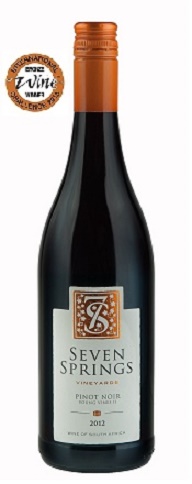Tasting Notes
A beautifully balanced, vibrant wine it is garnet in colour, with delicate woodland and truffle undertones. Offering opulent aromas of raspberries, cherries and strawberries, the oak is subtle, supporting the fruit driven profile of this wine. The palate is smooth and medium bodied, with bold fruit characters balanced well with the oak. A great food match with game, duck, and perfect with mushroom risotto

International Wine Challenge: Bronze 2015

Platter Wine Award: 4 Star 2015
Technical Analysis
Alcohol: 14.07%
Residual Sugar: 2.8 g/l
Total Acidity: 5.3 g/l
pH: 3.56
Harvested by hand on 14th and 17rd February 2012
Total production: 10,140 bottles (750ml)
Bottled: February 2013
Ageing potential: 5 years
Harvest Report
The 2012 harvest began on Valentine’s Day, with the Pinot Noir fruit being the first of the season to be picked. Strating soon after sunrise, the first sorting took place in the vineyard. At the winery the fruit was de-stemmed, crushed and pumped to stainless steel tanks, where it was left, for five days, to ‘cold soak’ at below 50˚F. The ‘cold-soaking’ process helped the extraction of primary fruit characters to enhance the fruit driven wine style. As the must warmed, the wild yeasts occurring naturally on the skins caused fermention to begin. After two weeks the alcoholic fermentation was complete and the grapes were pressed. It was then moved to second and third fill, French oak barrels and left to mature for 10 months. The older barrels complemented the fruit expression of this style of Pinot Noir; a light bodied, fruit forward wine. Juice from the different clones were kept separate during the whole process and only blended a few months before bottling.
The worlds best Pinot Noir is reputed to result from the selection of clones; a common practice in Burgundy. Clones 777 and 828 are currently favoured in addition to the reliable 114, 115 and 667. These clones are known for their strong colour, elegant rich aroma with hints of small fruits. They give the wine structure and potential for ageing. Seven Springs selected four clones: 777, 667, 115 and 459, planted in 2008, on the warmer north facing slope at 240 mters elevation on Bokkeveld Shale with decomposed granite and deep, rich yellow and red clay subsoil.
Review:
Tom Cannavan July 2014
Fear not that this is boldly declared as ‘young vines’. ‘Old Vines’ doesn’t necessarily guarantee quality, and believe me, this second vintage of wild yeast-fermented Pinot is fragrant and rich, with a touch of game and blood, solid plummy fruit and just a glimpse of more delicate floral and woodland nuances. It is juicy and savoury, the 10 months in older oak adding some clove and smokiness to really sweet fruit, a glimpse of raspberry ripple softness, but that plum and briar character and the 14% alcohol give it flesh and substance. Finishing on natural spice and deep-set fruit, it is a lovely Pinot in a more solid style, but not without elegance.










